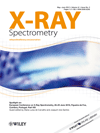
X-RAY SPECTROMETRY
Scope & Guideline
Transforming ideas into knowledge in the realm of spectroscopy.
Introduction
Aims and Scopes
- Development and Optimization of X-ray Techniques:
The journal emphasizes the advancement of X-ray fluorescence (XRF), X-ray diffraction (XRD), and resonant inelastic X-ray scattering techniques, aiming to improve methodology and instrumentation for enhanced analytical performance. - Interdisciplinary Applications of X-ray Spectrometry:
Research published in the journal spans multiple disciplines including archaeology, art conservation, environmental monitoring, and biomedical analysis, showcasing the versatility of X-ray techniques in diverse scientific inquiries. - Quantitative Analysis and Elemental Characterization:
A significant focus is placed on quantitative methodologies for detecting and analyzing micro and trace elements in various samples, including biological, geological, and industrial materials. - Innovative Applications in Cultural Heritage:
The journal highlights innovative uses of X-ray techniques in the study and conservation of cultural artifacts, including paintings, historical documents, and archaeological findings. - Environmental Monitoring and Health Risk Assessment:
Research related to environmental pollution and health risk assessment through X-ray techniques is a core area, addressing the detection of toxic elements in various matrices.
Trending and Emerging
- Integration of Machine Learning and AI in X-ray Analysis:
An emerging trend is the incorporation of machine learning techniques for data analysis and interpretation in X-ray spectrometry, enhancing the accuracy and efficiency of elemental characterization. - In-situ and Non-destructive Techniques:
There is an increasing focus on in-situ and non-destructive analysis methods that allow for the examination of samples without causing damage, particularly relevant in cultural heritage and forensic studies. - Applications in Health and Biomedical Fields:
Research exploring the use of X-ray spectrometry in health-related applications, such as the analysis of biological tissues and environmental exposure assessments, is gaining momentum. - Environmental and Ecological Monitoring:
Studies focused on environmental monitoring, particularly in relation to pollution and toxic element detection in ecosystems, have become increasingly prominent. - Advancements in Portable X-ray Technologies:
The development and application of portable X-ray devices for field studies and on-site analysis have surged, reflecting a trend towards accessibility and practical utility in diverse research settings.
Declining or Waning
- Traditional X-ray Techniques in Isolation:
There is a noticeable decrease in standalone studies focusing solely on traditional X-ray methods without the integration of modern techniques or interdisciplinary approaches, indicating a shift towards more complex analyses. - Limited Focus on Basic X-ray Theory:
Research papers that delve deeply into fundamental theoretical aspects of X-ray spectrometry have decreased, as the community appears to prioritize applied research and practical applications. - Reduction in Non-Environmental Industrial Applications:
The publication frequency of studies concentrating on industrial applications of X-ray spectrometry, particularly in non-environmental contexts, has waned, suggesting a pivot towards environmental and health-related topics.
Similar Journals

MRS Advances
Elevating Academic Dialogue in Material ResearchMRS Advances, published by Springer Heidelberg, is an esteemed academic journal that serves as a vital platform for disseminating cutting-edge research in the fields of condensed matter physics, materials science, and mechanical engineering. With an ISSN of 2731-5894 and an E-ISSN of 2059-8521, the journal is hosted in Switzerland and encompasses an impressive spectrum of innovative studies that impact both theoretical and practical applications. Throughout its converged years from 2012 and continuing through 2024, MRS Advances has established itself with notable rankings, including Q4 in condensed matter physics and Q3 in several related categories. This journal not only enriches the academic community with its rigorous peer-reviewed articles, but also encourages open discussions that further advance research innovations. Although currently not designated as an open-access journal, its accessibility through institutional subscriptions ensures that professionals, researchers, and students can engage with the latest advancements in the material science arena. Emphasizing its relevance, MRS Advances is dedicated to fostering interdisciplinary collaboration and inspiring new discoveries within the global research community.

Inorganic and Nano-Metal Chemistry
Catalyzing Discoveries in Inorganic and Nano-Metal Science.Inorganic and Nano-Metal Chemistry is a premier journal published by Taylor & Francis Inc, focusing on innovative research and advancements in the fields of inorganic chemistry and nano-metal applications. With an increasing impact in the academic community, this journal has established itself within the Q3 category of both Inorganic Chemistry and Physical and Theoretical Chemistry as of 2023, reflecting its global recognition and influence. The journal is accessible as an Open Access publication, ensuring that research findings are freely available to a broad audience, promoting transparency and collaboration in scientific exploration. Based in the United Kingdom, Inorganic and Nano-Metal Chemistry aims to disseminate high-quality peer-reviewed articles that not only highlight fundamental studies but also push the boundaries of technological applications in areas such as catalysis, materials science, and nanotechnology. Researchers, professionals, and students will find this journal an invaluable resource for the latest developments and interdisciplinary insights in the ever-evolving landscape of inorganic and nano-metal chemistry.

Quantum Beam Science
Exploring the Depths of Quantum Phenomena for AllQuantum Beam Science, published by MDPI since 2017, is an esteemed open-access journal that occupies a pivotal role in the fields of atomic and molecular physics as well as nuclear and high-energy physics. Based in Switzerland, this journal embraces a global community of researchers dedicated to advancing our understanding of quantum phenomena through innovative experimental and theoretical approaches. With an impactful presence reflected in its category quartiles—ranking Q3 in both the Atomic and Molecular Physics, and Nuclear and High Energy Physics categories—the journal aims to bridge the gap between foundational research and practical applications of quantum technology. Since adopting an open-access model, Quantum Beam Science has fostered greater accessibility to groundbreaking studies, facilitating knowledge dissemination among researchers and professionals alike. This commitment to open science empowers the next generation of physicists to contribute to a rapidly evolving discipline, ensuring that critical advancements reach a diverse audience. Stay informed on the latest developments in quantum research as the journal covers a wide range of topics, making it an essential resource for students, academics, and professionals in the field.

Nanoscale Research Letters
Empowering researchers to share groundbreaking findings.Nanoscale Research Letters, published by SPRINGER, is a leading open-access journal dedicated to the rapid dissemination of innovative research in the field of nanoscience and nanotechnology. Established in 2006, this journal provides researchers and professionals with a platform to share their groundbreaking findings across a broad spectrum of applications, including condensed matter physics and materials science. With an impressive Q1 ranking in both Condensed Matter Physics and Materials Science categories as of 2023, it asserts its position as a top-tier publication within the scientific community, bolstered by a 96th percentile rank in the Scopus database. Nanoscale Research Letters not only emphasizes the importance of nanotechnology research but also ensures that its findings are widely accessible, adhering to its open-access mandate. Scholars and students alike are encouraged to contribute to and engage with this dynamic resource, fostering collaboration and innovation in the ever-evolving world of nanoscience.
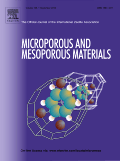
Microporous and Mesoporous Materials
Innovating Solutions through Mesoporous InsightsMicroporous and Mesoporous Materials is a leading academic journal published by ELSEVIER, specializing in the field of porosity characterization and applications of microporous and mesoporous materials. With an impactful Q1 ranking in various categories, including Chemistry, Condensed Matter Physics, and Materials Science, this journal serves as a vital resource for researchers, professionals, and students focused on advancing the understanding and application of these materials. Established in 1998 and set to continue its influence until 2024, the journal's rigorous peer-review process ensures the dissemination of high-quality research findings. Additionally, its commitment to open access publishing broadens accessibility, fostering an inclusive community dedicated to innovation in nanoscience, materials physics, and engineering. The journal's Scopus rankings highlight its prestigious standing, placing it among the top percentile within pertinent fields. For those engaged in cutting-edge research or education within these sectors, Microporous and Mesoporous Materials remains an essential journal for current advancements and insights.

JOURNAL OF CHEMICAL CRYSTALLOGRAPHY
Catalyzing knowledge in crystallography and condensed matter physics.Welcome to the Journal of Chemical Crystallography, a prominent publication dedicated to the advancement of knowledge in the fields of chemical crystallography, general chemistry, and condensed matter physics. Published by Springer/Plenum Publishers, this journal provides a critical platform for researchers, professionals, and students to disseminate and access innovative research findings and methodologies from 1994 to 2024. With an ISSN of 1074-1542 and E-ISSN 1572-8854, the journal currently holds a Q4 quartile ranking in both Chemistry and Condensed Matter Physics, reflecting its broadening scope and niche significance within the scientific community. While it operates under a traditional access model, it endeavors to promote high-quality research that advances theoretical and practical aspects of crystallography, making it an essential resource for those involved in these dynamic disciplines. Join us as we explore the intricate world of chemical structures and their properties, bridging gaps between chemistry and physics.
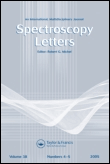
SPECTROSCOPY LETTERS
Advancing Knowledge in Analytical Chemistry and PhysicsSPECTROSCOPY LETTERS, published by Taylor & Francis Inc, is a pivotal journal that plays a significant role in the fields of Analytical Chemistry, Atomic and Molecular Physics, and Optics. With an ISSN of 0038-7010 and E-ISSN of 1532-2289, it provides a platform for the dissemination of cutting-edge research and developments in spectroscopy and its wide-ranging applications. As of 2023, the journal is ranked in the third quartile (Q3) across its relevant categories, reflecting its importance in these scientific domains. The journal has a continuous publication history from 1968 to 2024, establishing a rich legacy in academic literature. Although it currently does not offer Open Access options, SPECTROSCOPY LETTERS remains a valuable resource for researchers, professionals, and students seeking to advance their knowledge and applications in spectroscopy. For those in the arena of physics and chemistry, this journal is essential for keeping abreast of the latest findings and methodologies in the field.

New Materials Compounds and Applications
Bridging Theory and Practice in Materials ChemistryNew Materials Compounds and Applications is a pioneering journal published by JOMARD PUBLISHING, focusing on the latest advancements in materials science, particularly in the realms of analytical, inorganic, and organic chemistry. Since its inception in 2019, this journal has quickly established itself as a valuable resource for researchers and professionals seeking to explore innovative compounds and their applications across various fields. With an ISSN of 2521-7194 and an E-ISSN of 2523-4773, New Materials Compounds and Applications is indexed in Scopus, demonstrating its scholarly impact, albeit currently positioned in the Q3 and Q4 quartiles for several chemistry categories. The journal serves as a platform for disseminating research findings and fostering collaboration among scientists in Azerbaijan and beyond. Although it operates under a traditional access model, the journal aims to bridge the gap between theoretical studies and practical applications, making it essential reading for students and professionals looking to stay updated in the dynamic landscape of materials chemistry.
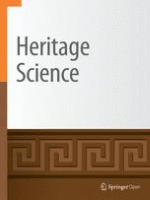
Heritage Science
Leading the Way in Innovative Heritage ResearchHeritage Science is a prestigious open-access journal, published by Springer since 2013, dedicated to the fields of heritage conservation and archaeology. With an ISSN of 2050-7445, it offers a platform for innovative research and critical discussions, encompassing interdisciplinary approaches that bridge the gap between art, science, and technology. The journal proudly ranks in the Q1 category for both Archaeology (arts and humanities) and Conservation, highlighting its influence and reputation within these scholarly realms. Furthermore, its presence in Scopus with impressive percentile rankings—such as #7 in Conservation and #23 in Archaeology (arts and humanities)—asserts its role as a leading voice in heritage studies. The journal's commitment to open access enhances the dissemination of knowledge, making it an essential resource for researchers, professionals, and students engaged in the preservation and interpretation of cultural heritage. Heritage Science continues to set standards in research quality, encouraging contributions that advance the understanding and sustainability of our shared heritage.
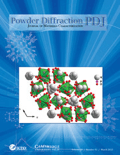
POWDER DIFFRACTION
Innovating Methodologies for a Deeper Understanding of MatterPOWDER DIFFRACTION, published by Cambridge University Press, is a pivotal journal focused on the evolving field of powder diffraction, which is crucial for researchers in condensed matter physics, materials science, and radiation studies. Established in 1986, this journal emphasizes the latest methodological advancements and applications in powder diffraction techniques, making it a comprehensive resource for professionals and students alike. With an ISSN of 0885-7156 and an E-ISSN of 1945-7413, it offers valuable insights into the characterizations of crystalline materials. Although currently not open access, the journal is highly regarded for maintaining rigorous peer review standards, reflecting in its rankings within the lower quartiles of relevant fields according to Scopus. Positioned within the United States and with distribution through Cambridge University Press, POWDER DIFFRACTION aims to foster innovation and knowledge exchange among the global scientific community, thereby solidifying its role as an essential platform for disseminating research findings from 1986 through to 2024 and beyond.